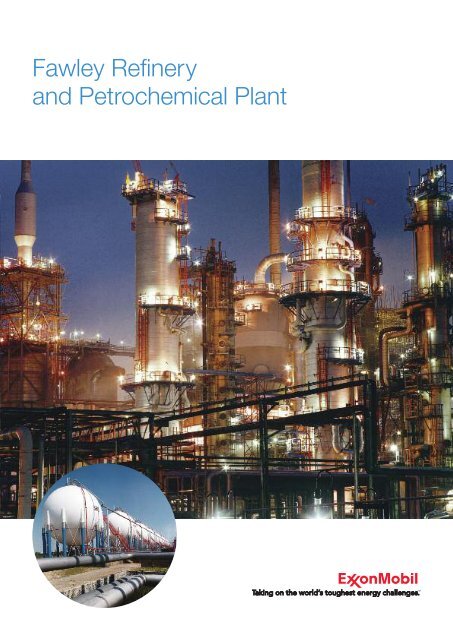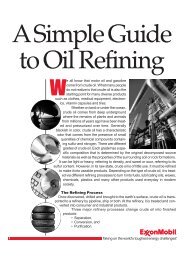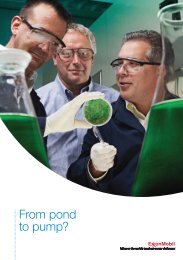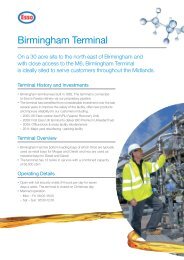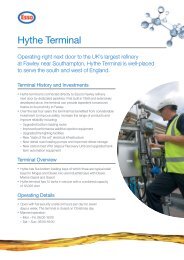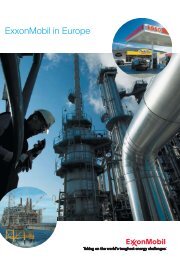Fawley Refinery and Petrochemical Plant - ExxonMobil in the UK
Fawley Refinery and Petrochemical Plant - ExxonMobil in the UK
Fawley Refinery and Petrochemical Plant - ExxonMobil in the UK
Create successful ePaper yourself
Turn your PDF publications into a flip-book with our unique Google optimized e-Paper software.
<strong>Fawley</strong> <strong>Ref<strong>in</strong>ery</strong><br />
<strong>and</strong> <strong>Petrochemical</strong> <strong>Plant</strong>
<strong>ExxonMobil</strong> is part of Exxon Mobil Corporation, which is <strong>the</strong><br />
world’s lead<strong>in</strong>g publicly-traded petroleum <strong>and</strong> natural gas company.<br />
Based <strong>in</strong> Texas, USA, <strong>the</strong> corporation has more than 80,000<br />
employees <strong>in</strong> 80 countries <strong>and</strong> bus<strong>in</strong>ess <strong>in</strong>terests across <strong>the</strong> globe.<br />
It was created by <strong>the</strong> merger of Exxon <strong>and</strong> Mobil <strong>in</strong> 1999.<br />
<strong>ExxonMobil</strong> is <strong>the</strong> largest gas producer <strong>in</strong> Europe. We supply about<br />
10 per cent of Europe's gas dem<strong>and</strong> <strong>and</strong> about 10 per cent of<br />
Europe's oil dem<strong>and</strong>. We are also one of Europe's lead<strong>in</strong>g<br />
manufacturers of petrochemical products.<br />
The company has its ma<strong>in</strong> <strong>UK</strong> offices at Lea<strong>the</strong>rhead <strong>in</strong> Surrey, <strong>and</strong><br />
operations <strong>in</strong> Engl<strong>and</strong>, Scotl<strong>and</strong> <strong>and</strong> Wales. The company provides<br />
work for approximately 7,500 employees <strong>and</strong> some 2,000<br />
contractors <strong>in</strong> <strong>the</strong> <strong>UK</strong>.<br />
The Esso, Mobil <strong>and</strong> <strong>ExxonMobil</strong> companies <strong>in</strong> <strong>the</strong> <strong>UK</strong> are wholly-owned subsidiaries of Exxon<br />
Mobil Corporation. <strong>ExxonMobil</strong> Corporation has numerous affiliates, many with names that<br />
<strong>in</strong>clude <strong>ExxonMobil</strong>, Exxon, Esso <strong>and</strong> Mobil. For convenience <strong>and</strong> simplicity <strong>in</strong> this publication,<br />
those terms, <strong>and</strong> <strong>the</strong> terms corporation, company, our, we <strong>and</strong> its, are sometimes used as<br />
abbreviated references to specific affiliates or affiliate groups.
<strong>Fawley</strong> <strong>Ref<strong>in</strong>ery</strong> <strong>and</strong> <strong>Petrochemical</strong> <strong>Plant</strong>
<strong>Fawley</strong> <strong>Ref<strong>in</strong>ery</strong> <strong>and</strong> <strong>Petrochemical</strong> <strong>Plant</strong>
<strong>ExxonMobil</strong> <strong>in</strong> <strong>the</strong><br />
<strong>UK</strong> <strong>and</strong> Irel<strong>and</strong><br />
<strong>Fawley</strong> <strong>Ref<strong>in</strong>ery</strong> <strong>and</strong> <strong>Petrochemical</strong> <strong>Plant</strong> is <strong>the</strong><br />
largest <strong>in</strong> <strong>the</strong> <strong>UK</strong>. Opened <strong>in</strong> 1951, it produces<br />
almost one fifth of <strong>the</strong> fuel used on <strong>the</strong><br />
country’s roads.<br />
Legend<br />
Fuels distribution term<strong>in</strong>al<br />
Office<br />
Gas process<strong>in</strong>g plant<br />
Gas term<strong>in</strong>al<br />
Chemicals manufactur<strong>in</strong>g plant<br />
NGL process<strong>in</strong>g plant<br />
<strong>Ref<strong>in</strong>ery</strong>, chemicals manufactur<strong>in</strong>g<br />
plant <strong>and</strong> mar<strong>in</strong>e term<strong>in</strong>al<br />
Airport operations<br />
LNG term<strong>in</strong>al<br />
Oil <strong>and</strong> gas fields<br />
Underground pipel<strong>in</strong>e<br />
Gas pipel<strong>in</strong>e<br />
Co-located service<br />
Dubl<strong>in</strong><br />
New Ross<br />
South Hook<br />
Avonmouth<br />
Newport<br />
Aberdeen<br />
Mossmorran<br />
Hy<strong>the</strong><br />
St Fergus<br />
W. London<br />
<strong>Fawley</strong><br />
<strong>Fawley</strong> <strong>Ref<strong>in</strong>ery</strong> <strong>and</strong> <strong>Petrochemical</strong> <strong>Plant</strong><br />
Birm<strong>in</strong>gham<br />
Bacton<br />
Purfleet<br />
Lea<strong>the</strong>rhead<br />
<strong>Fawley</strong> Refnery <strong>and</strong> <strong>Petrochemical</strong> <strong>Plant</strong><br />
Location: <strong>Fawley</strong>, Hampshire<br />
Opened: 1951<br />
Output: Jet fuel, petrol, diesel, lubricat<strong>in</strong>g oil, fuel oil, various chemicals<br />
Annual production capacity:<br />
• Up to 330,000 barrels of crude oil processed each day<br />
(15 million tonnes per year)<br />
• Over 850,000 tonnes of chemical products produced each year<br />
Number of workers on site: Over 2,300<br />
03
04 <strong>Fawley</strong> <strong>Ref<strong>in</strong>ery</strong> <strong>and</strong> <strong>Petrochemical</strong> <strong>Plant</strong><br />
Welcome to <strong>Fawley</strong><br />
Cover<strong>in</strong>g 3,250 acres on Southampton Water,<br />
<strong>Fawley</strong> <strong>Ref<strong>in</strong>ery</strong> <strong>and</strong> Chemical Manufactur<strong>in</strong>g <strong>Plant</strong><br />
is <strong>the</strong> largest <strong>in</strong> <strong>the</strong> <strong>UK</strong>, <strong>and</strong> one of <strong>the</strong> most<br />
complex <strong>in</strong> Europe.<br />
The first ref<strong>in</strong>ery on <strong>the</strong> site was developed by<br />
<strong>the</strong> Atlantic Gulf <strong>and</strong> West Indies Petroleum<br />
Company (AGWI) <strong>in</strong> 1921. Ever s<strong>in</strong>ce <strong>the</strong>n<br />
<strong>the</strong> site has played a key role <strong>in</strong> <strong>the</strong> area,<br />
provid<strong>in</strong>g jobs <strong>and</strong> help<strong>in</strong>g to susta<strong>in</strong> <strong>the</strong><br />
local community.<br />
After buy<strong>in</strong>g AGWI, Esso, which is now part<br />
of <strong>ExxonMobil</strong>, opened a new ref<strong>in</strong>ery on <strong>the</strong><br />
site <strong>in</strong> 1951 <strong>and</strong> some 60 years later it is still<br />
go<strong>in</strong>g strong.<br />
Today <strong>the</strong> ref<strong>in</strong>ery processes 330,000 barrels<br />
of crude oil every day, provid<strong>in</strong>g 20 per cent of<br />
<strong>the</strong> <strong>UK</strong>’s total ref<strong>in</strong><strong>in</strong>g capacity. Over 2,000<br />
ships visit <strong>Fawley</strong>’s modern mar<strong>in</strong>e term<strong>in</strong>al<br />
each year, deliver<strong>in</strong>g more than 22 million<br />
tonnes of crude oil <strong>and</strong> transport<strong>in</strong>g o<strong>the</strong>r<br />
products from <strong>the</strong> site.<br />
Some of <strong>the</strong> processed oil from <strong>the</strong> ref<strong>in</strong>ery is<br />
used as feed for <strong>the</strong> neighbour<strong>in</strong>g chemical<br />
plant, which manufactures over 850,000<br />
tonnes of petrochemical products every year.<br />
You can explore <strong>Fawley</strong> <strong>Ref<strong>in</strong>ery</strong> onl<strong>in</strong>e as<br />
part of an award-w<strong>in</strong>n<strong>in</strong>g virtual tour at<br />
http://resources.schoolscience.co.uk/<br />
exxonmobil/<strong>in</strong>dex.html<br />
Oil<strong>in</strong>g <strong>the</strong> wheels of everyday life<br />
Oil <strong>and</strong> chemicals play a vital role <strong>in</strong> every<br />
aspect of modern life. If you refuel your vehicle<br />
with petrol or diesel <strong>in</strong> <strong>the</strong> South of Engl<strong>and</strong>,<br />
<strong>the</strong>re is a strong chance <strong>the</strong> fuel was<br />
manufactured at <strong>Fawley</strong>. At home, you will<br />
be surrounded by products conta<strong>in</strong><strong>in</strong>g<br />
materials made from crude oil – from carpets<br />
to CDs; from toiletries to tra<strong>in</strong>ers; from pa<strong>in</strong>t<br />
to plastics.<br />
Your vehicle's tyre l<strong>in</strong><strong>in</strong>gs almost certa<strong>in</strong>ly<br />
conta<strong>in</strong> man-made rubber from <strong>Fawley</strong>, <strong>and</strong> if<br />
you board a boat, plane or tra<strong>in</strong>, it may well be<br />
us<strong>in</strong>g our fuel.<br />
Did you know ?<br />
At 1.5km long, <strong>Fawley</strong>’s mar<strong>in</strong>e<br />
term<strong>in</strong>al is <strong>the</strong> largest <strong>in</strong>dependently<br />
owned port of its type <strong>in</strong> Europe.
The production process<br />
Crude oil comes to <strong>Fawley</strong> <strong>in</strong> tankers from around<br />
<strong>the</strong> world – <strong>in</strong>clud<strong>in</strong>g <strong>the</strong> North Sea, Russia, West<br />
Africa <strong>and</strong> South America. <strong>Fawley</strong> typically processes<br />
over 20 different types of crude oil each year.<br />
Each tanker takes up to two days to unload its<br />
cargo, which is <strong>the</strong>n pumped to some of <strong>the</strong><br />
site’s 330 storage tanks. Each tank holds<br />
around 21,000 cubic metres of crude oil,<br />
enough to fill eight Olympic swimm<strong>in</strong>g pools.<br />
The crude oil is treated <strong>and</strong> converted at <strong>the</strong><br />
ref<strong>in</strong>ery <strong>in</strong>to consumer <strong>and</strong> <strong>in</strong>dustrial products<br />
us<strong>in</strong>g three ma<strong>in</strong> processes: separation,<br />
conversion <strong>and</strong> purification.<br />
Separation<br />
To beg<strong>in</strong> <strong>the</strong> ref<strong>in</strong><strong>in</strong>g process, <strong>the</strong> crude oil<br />
is separated <strong>in</strong>to its naturally occurr<strong>in</strong>g<br />
components by apply<strong>in</strong>g heat through a<br />
process called distillation. Primary separation is<br />
performed <strong>in</strong> a pair of distillation columns, with<br />
<strong>the</strong> bottom product from <strong>the</strong> first column<br />
feed<strong>in</strong>g <strong>the</strong> next. A furnace <strong>in</strong> front of <strong>the</strong><br />
column heats <strong>and</strong> vaporises <strong>the</strong> crude oil. The<br />
vapour <strong>and</strong> liquid mixture is <strong>the</strong>n fed <strong>in</strong>to <strong>the</strong><br />
bottom section of <strong>the</strong> tower. The feed section<br />
is <strong>the</strong> hottest po<strong>in</strong>t <strong>in</strong> <strong>the</strong> distillation column<br />
<strong>and</strong> ranges between 320°C to 370 °C.<br />
Components that are still liquid at such high<br />
temperatures become <strong>the</strong> column's bottom<br />
product, which is known as atmospheric<br />
residue. Components that are <strong>in</strong> vapour form<br />
rise up <strong>the</strong> tower through a series of distillation<br />
stages. The temperature decreases as <strong>the</strong><br />
vapours rise up <strong>the</strong> column <strong>and</strong> <strong>the</strong><br />
components condense.<br />
Because a liquid’s boil<strong>in</strong>g po<strong>in</strong>t decreases at<br />
lower pressures, <strong>the</strong> Atmospheric Residue is<br />
fur<strong>the</strong>r heated to over 400°C <strong>and</strong> distilled <strong>in</strong> a<br />
second column that operates under a vacuum<br />
to maximise liquid recovery. Products from <strong>the</strong><br />
distillation column range from gases at <strong>the</strong> top<br />
to very heavy, viscous liquids at <strong>the</strong> bottom.<br />
Conversion<br />
Distillation separates <strong>the</strong> crude oil <strong>in</strong>to<br />
unf<strong>in</strong>ished products. However, <strong>the</strong> products<br />
do not naturally exist <strong>in</strong> crude <strong>in</strong> <strong>the</strong> same<br />
proportions as <strong>the</strong> product mix that consumers<br />
dem<strong>and</strong>. Essentially, <strong>the</strong>re is too little petrol<br />
<strong>and</strong> too much of <strong>the</strong> heavier fuel oil naturally<br />
occurr<strong>in</strong>g <strong>in</strong> crude oil, so conversion processes<br />
are used to convert low-value fuel oil <strong>in</strong>to highvalue<br />
gasol<strong>in</strong>e <strong>and</strong> o<strong>the</strong>r lighter products.<br />
All products <strong>in</strong> <strong>the</strong> ref<strong>in</strong>ery are based on <strong>the</strong><br />
same build<strong>in</strong>g blocks: carbon <strong>and</strong> hydrogen<br />
cha<strong>in</strong>s, which are called hydrocarbons. The<br />
longer <strong>the</strong> carbon cha<strong>in</strong>, <strong>the</strong> heavier <strong>the</strong><br />
product will be. Convert<strong>in</strong>g heavier<br />
hydrocarbons to lighter hydrocarbons can<br />
be compared to cutt<strong>in</strong>g a l<strong>in</strong>k on a steel<br />
cha<strong>in</strong> to make two smaller cha<strong>in</strong>s. This is<br />
<strong>the</strong> function of <strong>Fawley</strong>'s Fluidised Catalytic<br />
Crack<strong>in</strong>g Unit (FCCU).<br />
In addition to break<strong>in</strong>g cha<strong>in</strong>s, <strong>the</strong>re are<br />
times when we want to change <strong>the</strong> form of<br />
<strong>the</strong> cha<strong>in</strong> or put cha<strong>in</strong>s toge<strong>the</strong>r. This is where<br />
<strong>the</strong> Powerformer <strong>and</strong> Isomerisation Units<br />
are necessary.<br />
The FCCU uses a catalyst (a material that<br />
helps make a chemical reaction go faster,<br />
occur at a lower temperature, or control which<br />
reactions occur) to convert gas-oil <strong>in</strong>to a mix of<br />
Liquefied Petroleum Gas (LPG), petrol<br />
<strong>and</strong> diesel.<br />
<strong>Fawley</strong> <strong>Ref<strong>in</strong>ery</strong> <strong>and</strong> <strong>Petrochemical</strong> <strong>Plant</strong><br />
05
06 <strong>Fawley</strong> <strong>Ref<strong>in</strong>ery</strong> <strong>and</strong> <strong>Petrochemical</strong> <strong>Plant</strong><br />
Atmospheric<br />
distillation<br />
30°C<br />
370°C<br />
CRUDE OIL<br />
OIL<br />
GASES<br />
NAPHTHA<br />
JET<br />
GAS OIL<br />
HEAVY GAS OIL<br />
ATMOSPHERIC RESIDUE<br />
Isomerisation<br />
Hydrof<strong>in</strong><strong>in</strong>g<br />
The heaviest material <strong>in</strong> <strong>the</strong> ref<strong>in</strong>ery is Vacuum<br />
Tower Bottoms (VTB) or residue. It is<br />
processed <strong>in</strong> <strong>the</strong> Residf<strong>in</strong>er which removes<br />
impurities so that it can be used as additional<br />
feedstock for <strong>the</strong> FCCU.<br />
Reform<strong>in</strong>g is <strong>the</strong> last conversion process. It<br />
<strong>in</strong>creases <strong>the</strong> octane number of petrol blend<br />
components <strong>and</strong> generates hydrogen for use<br />
<strong>in</strong> <strong>the</strong> ref<strong>in</strong>ery hydrof<strong>in</strong>ers. The same length<br />
carbon cha<strong>in</strong>s can have very different octane<br />
numbers based on <strong>the</strong> shape of <strong>the</strong> cha<strong>in</strong>.<br />
Straight cha<strong>in</strong>s, or paraff<strong>in</strong>s, have a relatively<br />
low octane number, whilst r<strong>in</strong>gs, or aromatics,<br />
have high octane numbers. At high<br />
temperatures <strong>and</strong> <strong>in</strong> <strong>the</strong> presence of<br />
hydrogen, <strong>the</strong> catalyst will “reform” paraff<strong>in</strong>s<br />
<strong>in</strong>to aromatics, hence <strong>the</strong> name catalytic<br />
reform<strong>in</strong>g. Some of <strong>the</strong> aromatics produced<br />
are used at <strong>Fawley</strong> <strong>in</strong> <strong>the</strong> production of<br />
petrochemicals, such as plastics <strong>and</strong> fabrics.<br />
Purifcation<br />
Once crude oil has been through separation<br />
<strong>and</strong> conversion, <strong>the</strong> result<strong>in</strong>g products are<br />
Reform<strong>in</strong>g<br />
Vacuum<br />
distillation<br />
ready for purification - pr<strong>in</strong>cipally sulphur<br />
removal to meet product quality specifications<br />
<strong>and</strong> environmental st<strong>and</strong>ards. This is done by<br />
Hydrof<strong>in</strong><strong>in</strong>g, <strong>in</strong> which <strong>the</strong> unf<strong>in</strong>ished products<br />
are fed <strong>in</strong>to a heated, high pressure chamber<br />
conta<strong>in</strong><strong>in</strong>g hydrogen <strong>and</strong> a catalyst.<br />
A fur<strong>the</strong>r process, sulphur recovery, converts<br />
hydrogen sulphide to water <strong>and</strong> sulphur,<br />
which is sold as a ref<strong>in</strong>ery byproduct.<br />
Chemical processes<br />
Some of <strong>the</strong> products that come out of <strong>the</strong><br />
ref<strong>in</strong>ery are transferred to <strong>the</strong> site’s major<br />
petrochemical plant. We also import butene<br />
to <strong>the</strong> plant, which is stored <strong>in</strong> seven large<br />
pressurised spheres, known as <strong>the</strong><br />
Seven Sisters.<br />
The raw materials pass through a series<br />
of complex processes to create a range<br />
of chemicals that have a wide variety of<br />
applications <strong>in</strong> <strong>the</strong> manufactur<strong>in</strong>g <strong>in</strong>dustry.<br />
The ma<strong>in</strong> products manufactured at <strong>the</strong><br />
plant are methyl ethyl ketone (MEK),
Residf<strong>in</strong><strong>in</strong>g<br />
a powerful solvent found <strong>in</strong> pa<strong>in</strong>ts <strong>and</strong><br />
adhesives, <strong>and</strong> halobutyl rubber used <strong>in</strong><br />
tyres. The majority of tyres manufactured<br />
<strong>in</strong> Europe conta<strong>in</strong> this type of rubber<br />
from <strong>Fawley</strong>.<br />
Fluid catalytic crack<strong>in</strong>g Scanf<strong>in</strong>er<br />
Travell<strong>in</strong>g far <strong>and</strong> wide<br />
About 80 per cent of <strong>Fawley</strong> <strong>Ref<strong>in</strong>ery</strong> output is<br />
pumped through underground pipel<strong>in</strong>es to<br />
distribution term<strong>in</strong>als as far afield as London,<br />
Bristol <strong>and</strong> Birm<strong>in</strong>gham. In total, 450<br />
miles/700km of pipel<strong>in</strong>e transport around<br />
25 million litres of product every day. A fur<strong>the</strong>r<br />
15 per cent of output is taken by sea to our<br />
export markets, while about 5 per cent travels<br />
by road or rail.<br />
Did you know ?<br />
Heathrow <strong>and</strong> Gatwick<br />
airports are both supplied with<br />
jet fuel by <strong>Fawley</strong>, us<strong>in</strong>g direct<br />
underground pipel<strong>in</strong>es.<br />
Lubes<br />
<strong>Fawley</strong> <strong>Ref<strong>in</strong>ery</strong> <strong>and</strong> <strong>Petrochemical</strong> <strong>Plant</strong><br />
End products<br />
LPG<br />
Petrol<br />
Jet Fuel<br />
Diesel<br />
Chemical Products<br />
Lubricants<br />
Mar<strong>in</strong>e Fuel<br />
07
08 <strong>Fawley</strong> <strong>Ref<strong>in</strong>ery</strong> <strong>and</strong> <strong>Petrochemical</strong> <strong>Plant</strong><br />
Safety, health <strong>and</strong><br />
<strong>the</strong> environment<br />
<strong>ExxonMobil</strong> is committed to ensur<strong>in</strong>g <strong>the</strong> health<br />
<strong>and</strong> safety of everyone work<strong>in</strong>g at <strong>Fawley</strong>, or liv<strong>in</strong>g<br />
<strong>in</strong> <strong>the</strong> surround<strong>in</strong>g area. This commitment extends<br />
to <strong>the</strong> protection of <strong>the</strong> local environment for <strong>the</strong><br />
good of residents <strong>and</strong> workers alike.<br />
Heath <strong>and</strong> safety<br />
We are extremely proud of our health <strong>and</strong><br />
safety record at <strong>Fawley</strong>. Our goal here, <strong>and</strong> at<br />
all our o<strong>the</strong>r sites, is to have a workplace<br />
where nobody gets hurt.<br />
Our award-w<strong>in</strong>n<strong>in</strong>g commitment to safety has<br />
been recognised many times, both with<strong>in</strong> <strong>the</strong><br />
<strong>in</strong>dustry, <strong>and</strong> by <strong>in</strong>dependent safety experts.<br />
We cont<strong>in</strong>ue to explore new <strong>and</strong> better<br />
ways to improve <strong>the</strong> safety <strong>and</strong> <strong>in</strong>tegrity of<br />
our operations.<br />
The environment<br />
The thriv<strong>in</strong>g saltmarsh that borders <strong>the</strong> site at<br />
<strong>Fawley</strong> is a Site of Special Scientific Interest<br />
(SSSI) that is home to over 20 species of<br />
birds. The rest of <strong>the</strong> site is surrounded by a<br />
thick screen of some 50,000 established trees<br />
<strong>and</strong> shrubs, which provide a natural<br />
woodl<strong>and</strong> habitat.<br />
Water plays an important role <strong>in</strong> <strong>the</strong><br />
production process at <strong>Fawley</strong>. Each day,<br />
<strong>the</strong> plant draws up to 1.8 million tonnes of<br />
seawater from Southampton Water, mostly for<br />
cool<strong>in</strong>g. When this is returned to <strong>the</strong> sea after<br />
purification, it’s often cleaner than when it was<br />
extracted.<br />
To help reduce energy consumption at <strong>Fawley</strong>,<br />
<strong>the</strong> plant uses a comb<strong>in</strong>ed heat <strong>and</strong> power<br />
generator (Cogen) that burns at twice <strong>the</strong><br />
efficiency of a conventional power station,<br />
cutt<strong>in</strong>g energy costs <strong>and</strong> reduc<strong>in</strong>g carbon<br />
emissions. The Cogen unit, which is owned<br />
<strong>and</strong> operated by Esso, is used to produce up<br />
to 230 tonnes of steam per hour for use <strong>in</strong> <strong>the</strong><br />
ref<strong>in</strong>ery, as well as electricity. Any electricity<br />
that is not consumed on site is fed <strong>in</strong>to <strong>the</strong><br />
National Grid, so <strong>Fawley</strong> is a net exporter of<br />
electrical power.<br />
Two o<strong>the</strong>r <strong>in</strong>itiatives are help<strong>in</strong>g to m<strong>in</strong>imise<br />
<strong>the</strong> site’s environmental impact. A recycl<strong>in</strong>g<br />
programme has helped to reduce <strong>the</strong> level of<br />
general waste at <strong>the</strong> ref<strong>in</strong>ery by <strong>in</strong>creas<strong>in</strong>g<br />
recycl<strong>in</strong>g to more than 80 per cent. The aim<br />
is to <strong>in</strong>crease this still fur<strong>the</strong>r until no general<br />
waste from <strong>the</strong> site needs to be sent to l<strong>and</strong>fill.<br />
Meanwhile, <strong>the</strong> ref<strong>in</strong>ery operates a series of<br />
biopiles, which use organic substances that<br />
are naturally present <strong>in</strong> soil to break down<br />
waste from <strong>the</strong> ref<strong>in</strong>ery so that any potential<br />
contam<strong>in</strong>ants are removed. This approach,<br />
which resembles a high technology compost<br />
heap, m<strong>in</strong>imises <strong>the</strong> amount of hazardous<br />
waste produced on site that needs to be sent<br />
away for <strong>in</strong>c<strong>in</strong>eration.<br />
Did you know ?<br />
<strong>Fawley</strong> pioneered <strong>the</strong> <strong>in</strong>troduction<br />
of lead-free petrol <strong>in</strong> <strong>the</strong> <strong>UK</strong>.
Did you know ?<br />
The <strong>Fawley</strong> <strong>Ref<strong>in</strong>ery</strong> was opened by<br />
Prime M<strong>in</strong>ister Clement Attlee on<br />
14 September, 1951.<br />
<strong>Fawley</strong> <strong>and</strong><br />
<strong>the</strong> community<br />
We have been part of <strong>the</strong> Waterside community<br />
for some 60 years. We firmly believe <strong>in</strong> be<strong>in</strong>g<br />
responsible neighbours <strong>and</strong> support our local area<br />
through a well-established programme of grants<br />
<strong>and</strong> assistance to local charities, schools <strong>and</strong><br />
community groups.<br />
<strong>ExxonMobil</strong> encourages employees <strong>and</strong> <strong>the</strong>ir<br />
families to contribute <strong>the</strong>ir time, talent <strong>and</strong><br />
energy to schools, charities <strong>and</strong> non-profit<br />
organisations. The company's Volunteer<br />
Involvement Programme (VIP) <strong>and</strong> Governor<br />
Scheme does this by recognis<strong>in</strong>g <strong>the</strong><br />
voluntary efforts of employees <strong>and</strong> <strong>the</strong>ir<br />
families, <strong>and</strong> reward<strong>in</strong>g <strong>the</strong> organisations <strong>the</strong>y<br />
support with grants of up to £1,000 per year.<br />
S<strong>in</strong>ce <strong>the</strong> programme began <strong>in</strong> 2002, <strong>the</strong><br />
<strong>Fawley</strong> representatives have given tens of<br />
thous<strong>and</strong>s of hours of <strong>the</strong>ir time to charities<br />
<strong>and</strong> local community groups, which have<br />
received grants under <strong>the</strong> scheme totall<strong>in</strong>g<br />
over half a million pounds.<br />
Many employees at <strong>Fawley</strong> also take part <strong>in</strong><br />
an annual Day of Car<strong>in</strong>g, <strong>in</strong> which <strong>the</strong>y give up<br />
a work<strong>in</strong>g day to participate <strong>in</strong> local<br />
community projects, such as clear<strong>in</strong>g <strong>the</strong><br />
ancient pond at Holbury Manor Park,<br />
remov<strong>in</strong>g undergrowth at <strong>the</strong> New Forest<br />
Front Nature Reserve <strong>and</strong> lay<strong>in</strong>g a new path<br />
at Lepe Country Park.<br />
<strong>ExxonMobil</strong> also makes donations direct to<br />
charities <strong>and</strong> community groups neighbour<strong>in</strong>g<br />
<strong>the</strong> <strong>Fawley</strong> site. The company covered <strong>the</strong><br />
£13,000 cost of <strong>the</strong> new, h<strong>and</strong>-crafted oak<br />
fence <strong>and</strong> gate at All Sa<strong>in</strong>ts Church, <strong>Fawley</strong>,<br />
for example. O<strong>the</strong>r examples of local<br />
donations, <strong>in</strong>clude sponsorship of community<br />
events, such as Hamble Week; help<strong>in</strong>g to fund<br />
<strong>the</strong> role of <strong>the</strong> Coastal Ranger at Lepe<br />
Country Park; <strong>and</strong> <strong>the</strong> purchase of digital<br />
cameras for <strong>the</strong> New Forest Agisters, to<br />
highlight <strong>the</strong> dangers of fail<strong>in</strong>g to slow<br />
down for animals.<br />
<strong>Fawley</strong> <strong>Ref<strong>in</strong>ery</strong> <strong>and</strong> <strong>Petrochemical</strong> <strong>Plant</strong><br />
09
10 <strong>Fawley</strong> <strong>Ref<strong>in</strong>ery</strong> <strong>and</strong> <strong>Petrochemical</strong> <strong>Plant</strong><br />
<strong>ExxonMobil</strong> also operates a L<strong>in</strong>k Schools<br />
programme with 10 schools <strong>in</strong> <strong>the</strong> <strong>Fawley</strong><br />
neighbourhood. Besides giv<strong>in</strong>g cash grants to<br />
local schools, this <strong>in</strong>itiative helps local<br />
teachers to show how <strong>the</strong> school curriculum is<br />
relevant to work<strong>in</strong>g life, while students ga<strong>in</strong> an<br />
appreciation of <strong>the</strong> importance of <strong>in</strong>dustry to<br />
<strong>the</strong>ir local economy <strong>and</strong> <strong>the</strong> skills needed for<br />
<strong>the</strong> world of work. <strong>ExxonMobil</strong> works<br />
alongside Learn<strong>in</strong>g through L<strong>and</strong>scapes - a<br />
national school grounds charity that believes<br />
that outdoor learn<strong>in</strong>g is an essential part of a<br />
child's development - <strong>and</strong> CREATE - a charity<br />
that encourages more susta<strong>in</strong>able uses of<br />
energy while reduc<strong>in</strong>g carbon emissions.<br />
For more than 12 years <strong>the</strong> site has also<br />
sponsored <strong>the</strong> Esso Maths challenge, an<br />
annual contest for Year 10 pupils <strong>in</strong> local<br />
schools. The Challenge <strong>in</strong>volves teams of<br />
students work<strong>in</strong>g toge<strong>the</strong>r to solve a series of<br />
very challeng<strong>in</strong>g ma<strong>the</strong>matical problems.<br />
The <strong>Fawley</strong> site also supports Local Authority<br />
<strong>in</strong>itiatives, such as New Forest District<br />
Council's Brilliance <strong>in</strong> Bus<strong>in</strong>ess Awards, <strong>in</strong><br />
which <strong>ExxonMobil</strong> has sponsored <strong>the</strong><br />
Innovation <strong>and</strong> Entrepreneurship category<br />
for several years. The site also supports<br />
Hampshire County Council's Hantsweb<br />
Awards, sponsor<strong>in</strong>g <strong>the</strong> category for <strong>the</strong> best<br />
website operated by secondary schools or<br />
colleges <strong>in</strong> <strong>the</strong> county.<br />
Local residents are welcome to visit <strong>Fawley</strong> on<br />
guided tours of <strong>the</strong> site. Each visit starts with<br />
an <strong>in</strong>troductory talk, followed by a coach tour<br />
of <strong>the</strong> site.<br />
Our Community Matters newsletter about <strong>the</strong><br />
<strong>Fawley</strong> site is distributed to local residents six<br />
times a year. This gives updates on operations<br />
at <strong>the</strong> plant <strong>and</strong> reports on any local projects<br />
<strong>in</strong>volv<strong>in</strong>g <strong>the</strong> plant <strong>and</strong> <strong>the</strong> people who<br />
work <strong>the</strong>re.<br />
Did you know ?<br />
We sponsor <strong>the</strong> <strong>Fawley</strong> onl<strong>in</strong>e<br />
website at www.fawleyonl<strong>in</strong>e.org.uk,<br />
which provides <strong>the</strong> latest news about<br />
what’s go<strong>in</strong>g on <strong>in</strong> <strong>the</strong> area <strong>and</strong><br />
electronic copies of our newsletter<br />
Community Matters.
<strong>Fawley</strong> <strong>Ref<strong>in</strong>ery</strong> <strong>and</strong> <strong>Petrochemical</strong> <strong>Plant</strong><br />
Esso <strong>Ref<strong>in</strong>ery</strong><br />
<strong>Fawley</strong><br />
Southampton<br />
SO45 1TX<br />
Telephone: 023 8089 2511<br />
© Esso <strong>UK</strong> Limited 2011<br />
This paper is manufactured at mills accredited<br />
with EMAS <strong>and</strong> ISO 14001 environmental<br />
certification <strong>and</strong> uses pulp derived from<br />
susta<strong>in</strong>able forests.<br />
Photography credits:<br />
Paul Carter, Keith Wood, Dirk Meußl<strong>in</strong>g,<br />
Janice Rub<strong>in</strong>, Ian Jackson, Chris Mart<strong>in</strong>,<br />
<strong>Fawley</strong> <strong>Ref<strong>in</strong>ery</strong> staff, Calor Gas Ltd,<br />
Williams Photography


